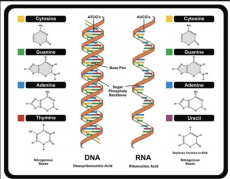

GCSE BIOLOGY REVISION: DNA STRUCTURE
Please note: Text in bold is what the AQA GCSE biology specification requires an understanding of.
Students should be able to describe DNA as a polymer made from four different nucleotides.
Each nucleotide consists of a common sugar and phosphate group with one of four different bases attached to the sugar.
DNA contains four bases, A, C, G and T.
A sequence of three bases is the code for a particular amino acid. The order of bases controls the order in which amino acids are assembled to produce a particular protein.
The long strands of DNA consist of alternating sugar and phosphate sections. Attached to each sugar is one of the four bases.
The DNA polymer is made up of repeating nucleotide units.
The structure of DNA
Watson and Crick are famous names that you may have come across. James Watson and Francis Crick were the ones to work out in the structure of DNA in 1953. By using data from other scientists (Rosalind Franklin and Maurice Wilkins) they were able to build a model of DNA. Using X-ray crystallography data, they showed that DNA consists of two strands coiled into a double helix.
DNA is a polymer made from four different nucleotides that are arranged in repeating fashion. A nucleotide is a structural component consisting of a base, a sugar molecule and a phosphate molecule. These bases are different to the bases discussed in relation to acids and alkalis in chemistry so do not get them mixed up! There are four bases found in DNA, these are:
Adenine (A)
Thymine (T)
Guanine (G)
Cytosine (C )
These bases pair up through complementary base pairing.
Adenine pairs with thymine (A-T)
Cytosine pairs with guanine (C-G)
3 base pairs sequences code for an amino acid, there are 20 different amino acids (don’t worry, you do not need to learn them all… but you will do if you choose to do a biology degree!) These 3 base pairs are known as a triplet code. The order of the bases therefore controls the order of which amino acids are assembled. The order of amino acids determines the protein made.
Exam Advice, mnemonics and revision tips
DNA structure can seem a bit complex and overwhelming. Read through your notes over and over again focusing on one bit at a time. Some like to find easy ways to remember base pairing. For example, Amy is dating Thomas (A-T), and George is dating Chloe (G-C). Students tend to remember rhymes and riddles, alternatively, some students like to turn the biology into a little story. Whatever works best for you! It is good practice to draw things out. Biology lives for diagrams and schematics! Using drawings is a good way to test whether you fully understand what you have learnt.
In terms of exam preparation, once you have read through the work, test yourself. Maybe ask a friend or a family member to quiz you on it, Q cards are very useful for this. Then do past paper exam questions. The more you practice, the easier it becomes. Soon, it will all come naturally to you, it just takes time and practice!
Image- https://www.livescience.com/37247-dna.html

0 Comment:
Be the first one to comment on this article.